Are you an artisan, maker, or creative entrepreneur ready to share your craft with the world? Your work deserves more than just a social media feed; it deserves a dedicated online space that tells your story and sells your creations. Artisan websites act as digital storefronts and portfolios where your craftsmanship, brand story, and handmade products can truly shine.
This guide will provide you with valuable insights into what makes artisan websites successful. We will explore the essential elements of great artisan website design, from stunning visuals to intuitive navigation that enhances user experience.
You will also discover inspiring examples of the best artisan websites in the industry and learn about the tools and platforms that can help you build your own.
By the end, you will have a clear roadmap to create a site that not only looks beautiful but also helps your business grow and attract loyal customers.
What Are Artisan Websites and Why They Matter for Handmade Brands?
A well-crafted artisan website is far more than an online store. It’s a digital representation of your brand’s soul. It’s where your creative process meets the digital world, allowing you to connect with a broader audience and build a loyal following.

Defining Artisan Websites: Showcasing Handmade Work with Story
What is an artisan website?
At its core, it’s an online platform dedicated to showcasing handmade, unique, or custom-made goods. Unlike a generic ecommerce site, it’s built with a focus on storytelling.
These sites act as virtual galleries, where every product has a narrative. They highlight the personal touch and the dedication that goes into each piece.
A good artisan website helps you tell your own story, from the inspiration behind a product to the materials you use. It creates a personal connection between the maker and the customer, something mass-produced goods can never achieve.
Importance of Artisan Website Design for Brand Identity and Sales
A professional and visually stunning artisan website design is crucial for several reasons. First, it builds trust.
When a potential customer lands on a professional-looking site, it signals that your business is legitimate and that you take your craft seriously. This is especially important in the artisan industry, where customers buy a piece of you and your creative spirit.
Second, a great design improves user engagement. An intuitive layout and beautiful imagery encourage visitors to stay longer, explore more products, and delve into your brand’s story. This prolonged engagement often leads to higher conversion rates.
Ultimately, your artisan website is a powerful tool for boosting sales and establishing a strong, cohesive brand identity in today’s digital age.
Build Your Own Artisan Website with Expert WordPress Design
Take your craft online with a custom WordPress website designed to showcase your artistry and grow your business.
Key Design Principles That Make Artisan Websites Shine
The best artisan websites aren’t just beautiful; they are thoughtfully designed to showcase the work and captivate the audience. Here are some of the key elements you should consider for your own site.
High-Quality Visuals and Story-Driven Layouts
When it comes to handmade goods, seeing is believing. High-quality visuals are non-negotiable. This includes clear, well-lit photographs of your products, but it goes beyond that. Consider including images of your workspace, your creative process, and the raw materials you use. These visuals are part of your story.
Many of the best artisan websites use a story-driven layout that guides the visitor’s journey. For example, a home page might feature a large, compelling banner image, followed by a section about the artist and their inspiration.
The website for CyberOptik, for instance, uses a narrative-driven approach to highlight its design process and portfolio.
Clean, Intuitive Navigation and Minimalist Layouts
While your work may be intricate, your website’s navigation should be simple. Clean navigation is a cornerstone of good artisan web design.
Visitors should be able to find what they’re looking for without frustration. Simplified menus, clear calls to action, and uncluttered pages are essential for a positive user experience.
A minimalist design works well for many artisan websites. It puts the focus squarely on your products. A white background or neutral palette makes your products pop and prevents the page from feeling overwhelmed.
Sites like Strikingly are a great example of how a sleek design can be both professional and highly effective.
Organic Color Palettes and Rustic Typography
The colors and fonts you choose can reinforce the handmade, natural feel of your products. A natural color palette with earthy tones often works best.
Think of a brown color palette, soft greens, or warm creams. These colors evoke a sense of authenticity and connection to nature.
Similarly, elegant typography can set the tone. Fonts that feel handcrafted or a bit rustic add a personal touch. While you should avoid overly complex fonts for body text, a bold font for headings can be a powerful statement.
Interactive Elements: Blogs, Behind-the-Scenes, Video Features
A static website can be beautiful, but interactive elements can create a more engaging experience. A blog section is a fantastic way to share your creative process, new ideas, or your journey as an artisan.
A “How It’s Made” page with a video or step-by-step photos can mesmerize visitors and help them develop a deeper appreciation for your work.
This could be a short video on the home page, an “About Me” page with a personal story, or a customer review section. These elements help build a genuine community around your brand and increase user engagement.
Inspiring Examples of Artisan Websites That Get It Right
Studying the best artisan websites is a fantastic way to gain valuable insights and design examples for your own digital space. These sites go beyond simple product listings to create an immersive and memorable experience.
Almost Real
This brand for custom accessories showcases a masterful blend of sleek, modern design with a personal, handcrafted feel.

The site uses a clean, grid-based professional layout to highlight its handmade products. A simple color palette and generous white space ensure that the high-quality images and vibrant product colors take center stage, creating a striking visual appeal.
Benjamin Hardman
A professional photographer’s site, Benjamin Hardman’s virtual space, is an excellent example of how a minimalist design can create a powerful impact. His website uses large, full-screen images and video to immerse visitors in his stunning landscapes.
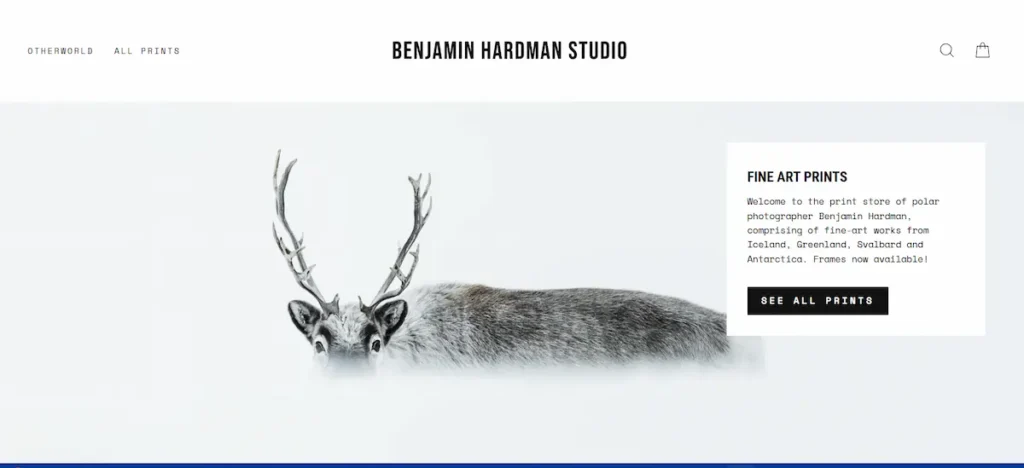
The focus is entirely on his artist’s works, with a simple, unobtrusive menu allowing easy navigation. This design makes visitors feel like they are in a digital gallery, not just a website.
Emily Jeffords
Emily Jeffords’ website seamlessly extends her artistic style as a painter. The site features a soft, elegant, creative color scheme and elegant typography that reflect her work.
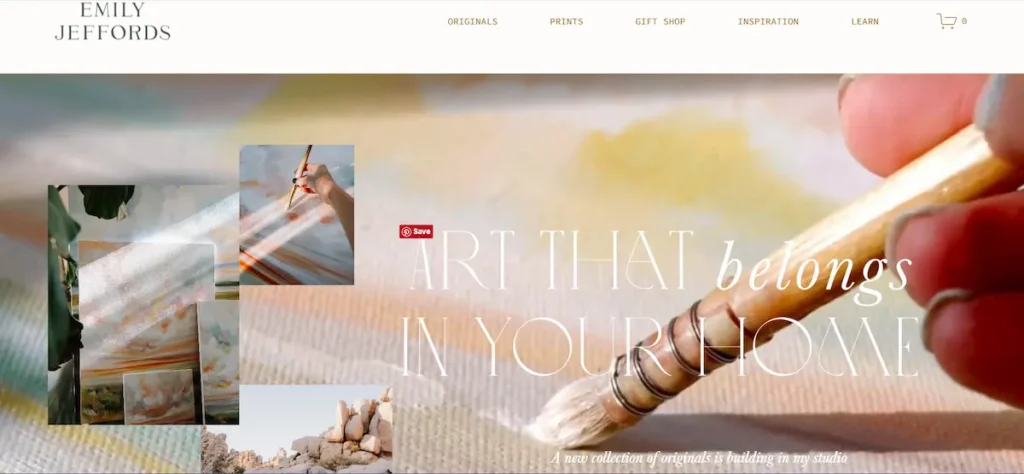
The visual elements are carefully curated to tell a story about her creative process and inspiration. The layout is clean and intuitive, making it easy to browse her collections, read her blog, and sign up for her newsletter, all while maintaining a warm and inviting feel.
WorkOf
This site, which features a collective of independent designers, showcases how to present diverse artisan products cohesively.
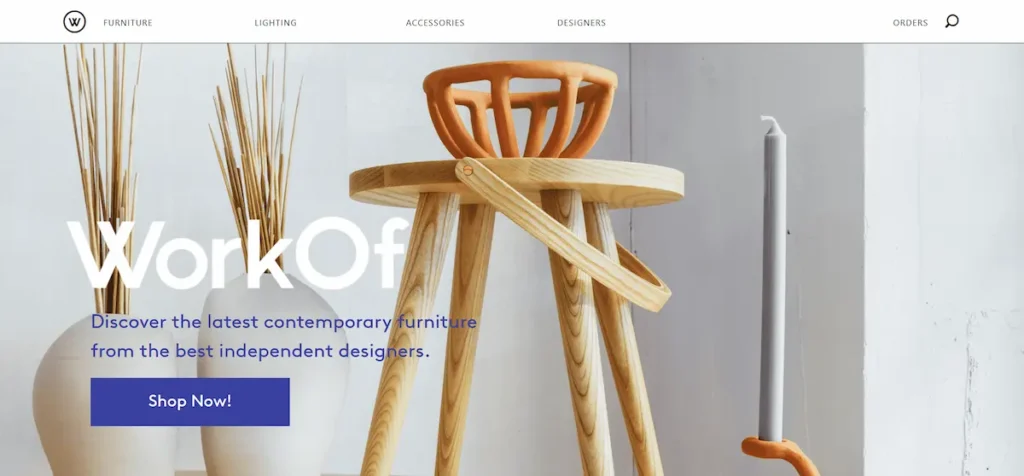
WorkOf uses a gallery-like professional layout to showcase furniture, lighting, and home decor from various makers.
The site’s sophisticated and clean aesthetic allows each piece’s unique style to shine, providing a rich source of design inspiration for visitors.
Samantha Keely Smith
An abstract artist, Samantha Keely Smith’s website uses a rich, dark background to create a dramatic contrast that makes her artwork pop.
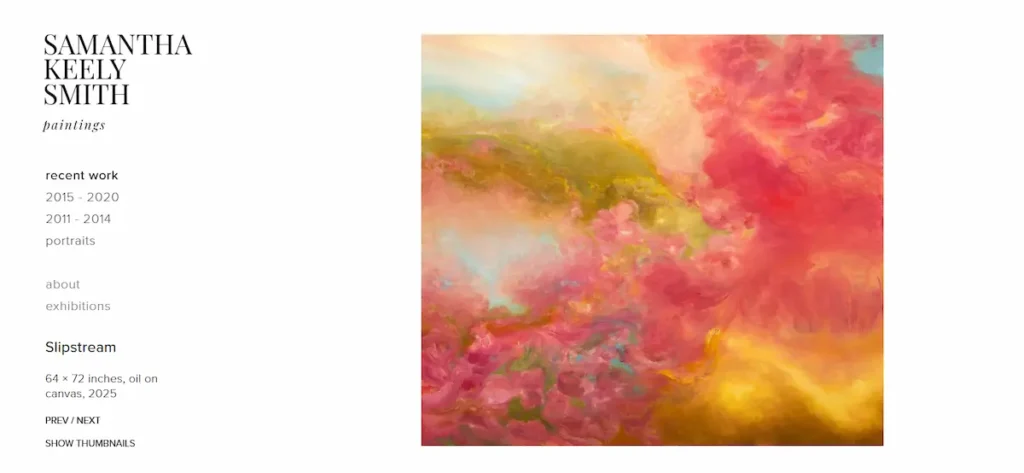
The site is a prime example of how a creative color scheme can set a mood and enhance the viewer’s experience.
The subtle animations and smooth transitions on the site add a layer of sophistication, guiding the user through her portfolio gracefully.
Bowery & Grand
Bowery and Grand focus on high-quality handcrafted goods, and its website reflects that commitment. The design is rustic yet refined, focusing on tactile materials and a warm color palette.
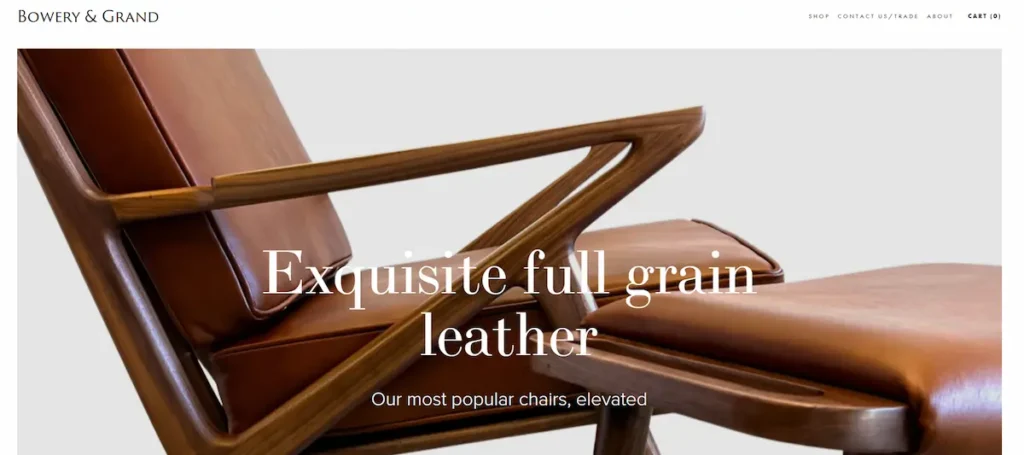
The product descriptions are detailed and tell the story of each piece, giving the customer a deeper connection to the handmade products.
Steeven Salvat
Steeven Salvat, an artist known for his intricate pen-and-ink drawings, showcases his meticulous work on his site.

The website has a clean, minimalist design with a white background and sharp typography. This choice ensures that the detail in his works is the main focus. The site’s simplicity is its strength, proving that sometimes less is truly more.
Erin Rigney
Erin Rigney‘s website, dedicated to her abstract art, is a brilliant example of a visually stunning portfolio. Its professional layout uses large, high-resolution images that dominate the screen.

The site’s flow is smooth and logical, with clear sections for her portfolio, process, and bio, making it easy for potential clients and fans to explore her work.
General Store
This brand’s website has a warm, welcoming feel that perfectly captures the spirit of a rustic, charming general store. The site is a great example of using a more organic, less structured layout to create a unique atmosphere.
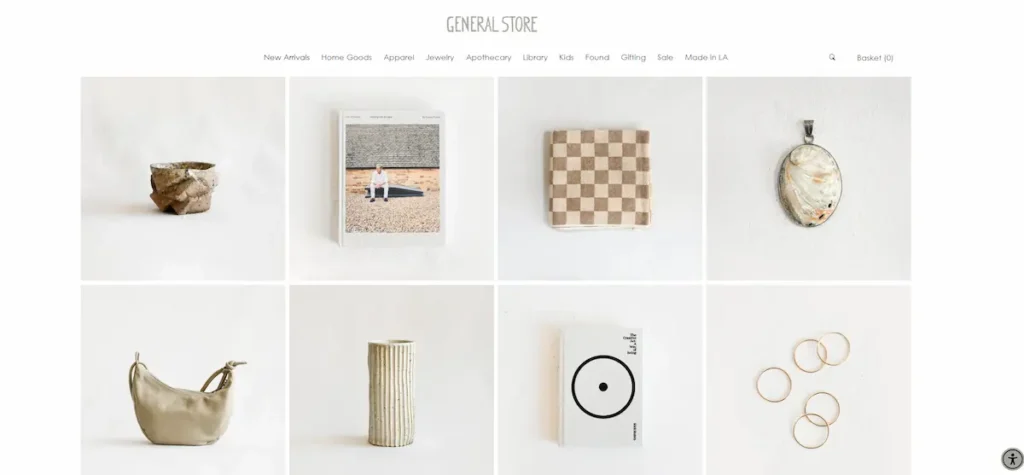
The visual elements and product photography evoke a sense of home and comfort, making it a delightful space to browse for artisan products.
Lindsay Letters
The website for Lindsay Letters is a brilliant example of how an artisan brand can blend creativity with functionality. Lindsay, a lettering artist and painter, uses her site to showcase her artwork in a way that feels both personal and professional.

The design highlights her hand-painted pieces through large, high-quality visuals, soft color palettes, and intuitive navigation. The site not only reflects her artistic style but also makes it easy for visitors to shop collections, read her story, and connect with her brand on a deeper level.
WordPress Recommendations for Building Artisan Websites
When it comes to creating a professional and scalable artisan website, WordPress is the best platform available. At Seahawk, we focus exclusively on WordPress because it offers unmatched flexibility, endless customization, and a vast ecosystem of themes, plugins, and tools to bring your vision to life.
WordPress with Artisan-Friendly Themes and Builders
WordPress makes it simple to build anything from a minimalist portfolio to a full-featured ecommerce store. With artisan-friendly themes and page builders like Elementor or Divi, you can design a visually stunning site without touching a single line of code.
These builders provide beautiful, customizable templates that are perfect for showcasing creative portfolios, promoting workshops or events, and even running online shops.
For artisans and studios, this means you get an eye catching own site that reflects your unique brand identity while being functional and easy to manage.
Why Seahawk Chooses WordPress for Artisans
Unlike other platforms, WordPress grows with your business. Whether you want to add a gallery to feature beautiful spaces, integrate an email list for promotions, or launch an ecommerce store, WordPress provides the scalability you need.
At Seahawk, our expert team specializes in building custom WordPress websites that are tailored to artisans and creative professionals, ensuring your site is not only visually striking but also SEO-optimized, responsive, and user-friendly.
Tips for Branding, SEO, and User Engagement on Artisan Sites
Building a beautiful website is only half the battle. To succeed, you need to consider how you will attract visitors, engage them, and convert them into customers.
Crafting a Brand Identity That Resonates
Your brand identity is more than just a logo. It’s the feeling people get when they interact with your brand.
For an artisan, this means your about page, the voice of your product descriptions, and your site’s entire look and feel should be consistent. A well-defined brand identity builds trust and helps customers feel a deeper connection to you and your products.
Optimizing for SEO with Keywords and Story Content
Search Engine Optimization (SEO) helps customers find your site on Google and other search engines. For artisan websites, this means using relevant keywords in your content. Don’t just use a generic term like “handmade shoes.” Instead, use more specific, long-tail keywords like “handmade shoes made from ethically sourced leather.”
Include these keywords in your product titles, descriptions, and blog posts. Also, remember to use them in the alt text for your images. A blog is a fantastic way to improve your SEO and provide valuable insights to your audience.
Enhancing UX with Clear Navigation and Mobile Responsiveness
A website must look great and function perfectly on any device. Mobile responsiveness is not an option; it’s a necessity.
Your artisan website should load quickly on phones and have a simple menu that is easy to use with a thumb.
Check your site on different devices and browsers to ensure a smooth user experience. A positive user flow from home to product pages can significantly increase conversions.
Driving Engagement with Content and Community
Beyond products, people are buying into your story. Use your website to share that story. A blog can feature tutorials, behind-the-scenes looks at your studio, or interviews with other artisans.
You can also drive user engagement by encouraging newsletter sign-ups, which allows you to build a community and announce new products or workshop dates. Social media integration is also key.
Measuring Performance and Iterating Based on Data
To ensure your artisan website is working effectively, you need to track its performance. Use tools like Google Analytics to see where your visitors are coming from, which pages they visit most, and where they leave. This data provides valuable insights into what’s working and what isn’t.
By analyzing your artisan website analytics, you can make small, data-driven changes that can lead to big improvements in conversion and engagement.
Conclusion: Crafting Your Own Artisan Website That Inspires and Converts
Creating an artisan website is a powerful act of personal expression. It’s your chance to control your narrative, showcase your work, and connect with customers on a deeper level. The best artisan websites blend art and strategy.
They use high-quality images, a clean layout, and compelling storytelling to create a visually stunning and engaging experience.
Remember to choose the right platform for your needs, whether it’s the flexibility of WordPress, the ecommerce power of Shopify, or the custom website control of Webflow.
Focus on visually appealing design, clear navigation, and an authentic brand identity. And don’t forget to optimize for SEO and mobile responsiveness to reach the widest audience possible.
By blending your creative vision with purposeful design and data-driven refinement, you can build an artisan website that inspires and converts your audience into a community of loyal customers.
FAQs on Artisan Website Design
What are the key elements of a successful artisan website?
The key elements include a modern design, strong visual appeal, and a user-friendly layout. High-quality images of artisan products, straightforward navigation, and subtle animations help visitors engage with the artist’s works.
How can modern design improve an artisan website?
The site’s modern design ensures that it feels fresh and professional. Clean typography, vibrant colors, and creative color schemes make handmade products stand out. It also supports responsive layouts, ensuring the site works seamlessly across devices.
Where can I find design inspiration for artisan websites?
Design inspiration can come from successful design examples such as Almost Real, Emily Jeffords, or WorkOf. Exploring how brands like Aurora Shoe and Alexander Designs showcase their handmade products can spark fresh ideas.
What makes a great “About” page for an artisan site?
An About page should tell the artist’s story in a relatable way. Sharing the journey, inspiration, and creative process builds trust and connects visitors to the unique style behind the artisan products. It is one of the most valuable tips for making the site personal and authentic.
Why are design examples important for artisans building websites?
Design examples provide practical guidance on layout, visual elements, and presentation. By studying sites like General Store or Steeven Salvat, artisans can understand how to blend professional layout with creativity, resulting in a user-friendly virtual space.



